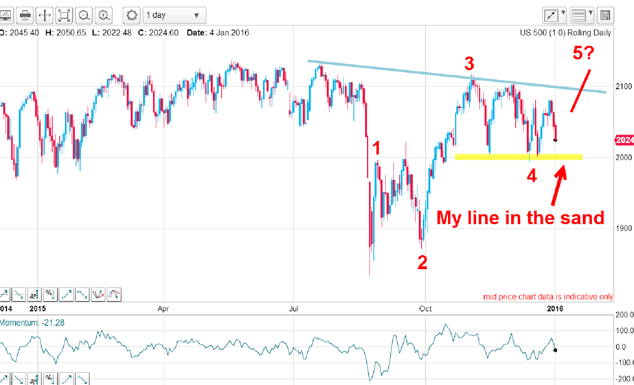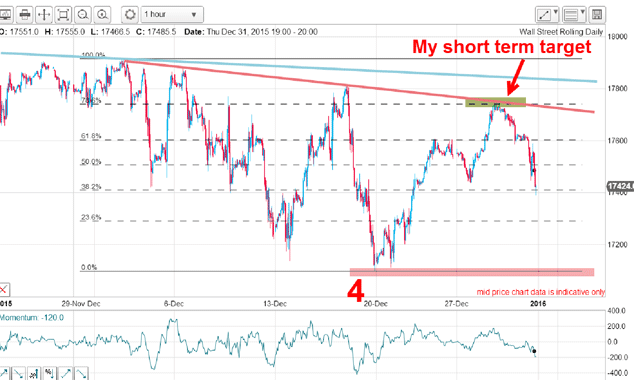2016 already looks good for traders
This year promises to be full of opportunities, says John C Burford. But first, traders must stick to these two New Year's resolutions.
A happy New Year to all my readers!
The old year certainly went out like a lion with very strong gales and floods here in the UK. And markets were no less turbulent. Last week in the supposedly quiet holiday period my main markets went through impressive moves. If you are serious about trading, you need to be alert whenever markets are open if you are to grab the best opportunities.
And this morning, stocks are down hard. China was leading the way with a 7% collapse when trading was halted. I wonder, incidentally, if the Chinese authorities will put their 'plunge protection team' to work now (as they did in August)?
MoneyWeek
Subscribe to MoneyWeek today and get your first six magazine issues absolutely FREE

Sign up to Money Morning
Don't miss the latest investment and personal finances news, market analysis, plus money-saving tips with our free twice-daily newsletter
Don't miss the latest investment and personal finances news, market analysis, plus money-saving tips with our free twice-daily newsletter
So, in my first postof 2016, I will review the S&P and Dow, which was strong leading up to the holiday period and now is falling back.
Market moves you might have missed
But in the holiday week, the Dow rallied a massive 650 points to last Tuesday's high and then promptly gave up over 500 points in the last three trading days.
In fact, this pattern is an exact copy of market action one year ago when the market fell hard from a 26 December high into early January's low.
This volatility is simply continuing the theme that characterised much of 2015. Despite the indexes going practically nowhere, the swings have been large and rapid. In these conditions, a swing trader needs to stay very alert. This market was not a 'set and forget' one and trend-followers were generally crushed.
What message was the market sending in 2015? To me, it was playing out an epic tug-of-war battle between the inflationary effects of the Fed's 'stimulus' machinery and the growing deflationary forces as reflected in falling commodity prices. This battle is entirely expected in an ending drama of a super-long bull market that really started after WWII when central banks started throwing their weight around.
Pundits are bullish but I still think tech's in a bubble
But as a warning that the economy is not the stockmarket, recall that in the 1990s bubble, the 12 leading tech shares lead by Microsoft, Dell, Cisco and Intel, saw their valuation balloon from $900bn to $4trn in the four years to the 2000 top. They then collapsed to less than $900bn in the next decade all the while their sales and revenues continued to grow. The tech economy was up, yet stocks went down. Let that be a lesson to investors and traders alike.
If you were invested in the Fang quartet, you would have seen their valuations zoom up by $500bn of market capitalisation during 2015, while the remaining 496 shares in the S&P 500 lost the same amount. That suggests a fractured and deeply unhealthy market.
My first forecasts of 2016
Here is the updated daily S&P chart I have shown before. For this forecast for a wave 5 above 2,100 to stand a chance, the market should not break the wave 4 low around 2,000:

That is my line in the sand and it falls around the 2,000 level. The equivalent in the Dow is the 17,100 level (currently 17,200).
But what was interesting in the Dow last week was this hourly chart:

As the market rallied off the wave 4 low just before Christmas, I set my first target at the crossing of the Fibonacci 78% level and the short-term trend line (pink line). I have marked my blue trend line from the first chart. Note that this pink trend line has three accurate touch points which gives me high confidence that it is a line of resistance.
I knew that if the market could reach that level, the enhanced resistance presented by this conjunction should be enough to turn he market back down and a great place to take profits on long positions. And that is precisely what I did.
I was glad I did with the market now in collapse mode. And all I did was use my split-bet strategy (with discipline).
So what is my near-term forecast? Here is the hourly S&P chart in close-up:

The rally off the wave 4 low is a clear five up, which could complete wave 5 (see later), despite no new high. The decline has carried to the Fibonacci 78% level as I write. This is one of the potential major turning points.
But with this morning's action, my outlook for a new high becomes less and less likely. So does that destroy my previous forecast for a fifth wave? Not necessarily we could be looking at a truncated fifth, where wave 5 does not exceed the wave 3 high. These are relatively uncommon, but would fit the current situation.
And if we do have a truncated fifth, the outlook is very bearish indeed.
Two New Year's resolutions worth keeping
Most big losses that wipe out accounts are down to lack of strict money management discipline. And that comes from an almost religious faith that your trade is a shoo-in and cannot lose.
Reality check: no trade is destined to be an automatic winner just because you believe it.
I have devised two simple rules that should keep you out of trouble. They are the 3% rule and the break even rule. Use them and let your winners run in 2016!
Get the latest financial news, insights and expert analysis from our award-winning MoneyWeek team, to help you understand what really matters when it comes to your finances.
John is is a British-born lapsed PhD physicist, who previously worked for Nasa on the Mars exploration team. He is a former commodity trading advisor with the US Commodities Futures Trading Commission, and worked in a boutique futures house in California in the 1980s.
He was a partner in one of the first futures newsletter advisory services, based in Washington DC, specialising in pork bellies and currencies. John is primarily a chart-reading trader, having cut his trading teeth in the days before PCs.
As well as his work in the financial world, he has launched, run and sold several 'real' businesses producing 'real' products.
-
 Millions of parents are missing out on up to £720 a year in extra pension cash – are you affected?
Millions of parents are missing out on up to £720 a year in extra pension cash – are you affected?A mum who narrowly missed out on the pension boost said she “never knew the government rule existed” and wants other parents to use it
-
 The most influential people of 2025
The most influential people of 2025Here are the most influential people of 2025, from New York's mayor-elect Zohran Mamdani to Japan’s Iron Lady Sanae Takaichi